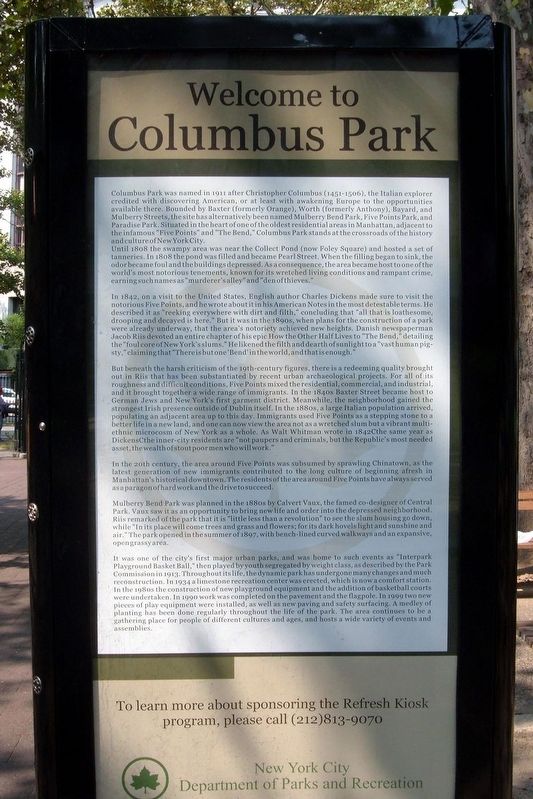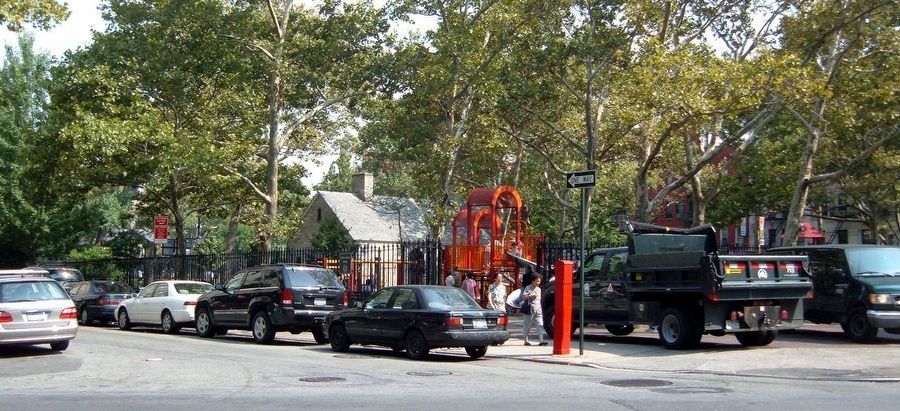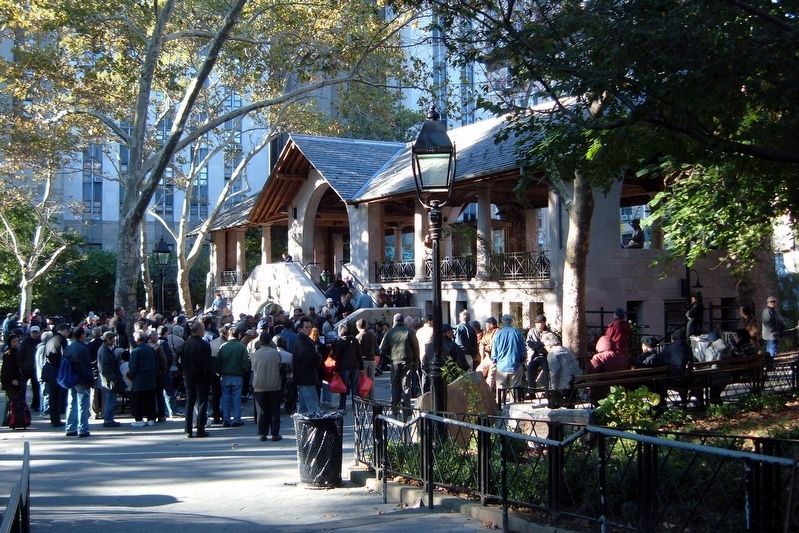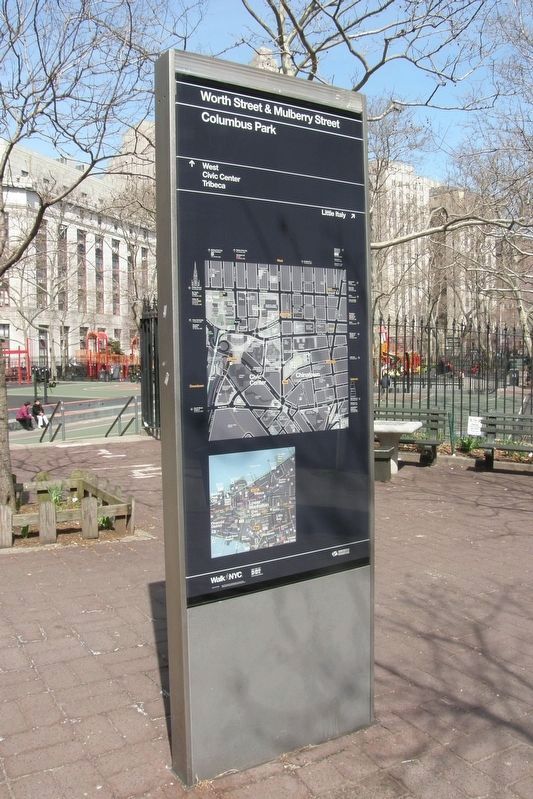Chinatown in Manhattan in New York County, New York — The American Northeast (Mid-Atlantic)
Welcome to Columbus Park
Columbus Park was named in 1911 after Christopher Columbus (1451-1506), the Italian explorer credited with discovering America, or at least with awakening Europe to the opportunities there. Bounded by Baxter (formerly Orange), Worth (formerly Anthony), Bayard, and Mulberry Streets, the site has alternatively been named Mulberry Bend Park, Five Points Park, and Paradise Park. Situated in the heart of one of the oldest residential areas in Manhattan, adjacent to the infamous "Five Points" and "The Bend”, Columbus Park Stands at the crossroads of the history and culture of New York City.
Until 1808 the swampy area was near the Collect Pond (now Foley Square) and hosted a set of tanneries. In 1808 the pond was filled and became Pearl Street. When the filling began to sink, the odor became foul and the buildings depressed. As a consequence, the area became host to one of the world's most notorious tenements, known for its wretched living conditions and rampant crime, earning such names as "murderer's alley" and "den of thieves."
In 1842, on a visit to the United States, English author Charles Dickens made sure to visit the notorious Five Points, and he wrote about it in his American Notes in the most scathing terms. He described it as "reeking everywhere with dirt and filth," concluding that "all that is loathsome, drooping and decayed is here." But it was in the 1890’s, when plans for the construction of a park were already underway, that the area's notoriety achieved new heights. Danish newspaperman Jacob Riis devoted an entire chapter of his epic How the Other Half Lives to "The Bend," detailing the "foul core of New York's slums." He likened the filth and dearth of sunlight to a "vast human pig-sty," claiming that "There is but one 'Bend' in the world, and that is enough."
But beneath the harsh criticism of the 19th century figures, there is a redeeming quality brought out in Riis that has been substantiated by recent urban archeological projects. For all its roughness and difficult conditions, Five Points mixed the residential, commercial, and industrial elements in an unprecedented fashion, bringing together a wide array of immigrants. In the 1840s, Baxter Street became host to German Jews and New York's first garment district. Meanwhile, the neighborhood gained the strongest Irish presence outside of Dublin itself. In the 1880s, a large Italian population arrived, populating an adjacent neighborhood that remains to this day. Immigrants used Five Points as a stepping stone to a better life in a new land and one can now view the area not as a wretched slum but a vibrant multi-ethnic microcosm of New York as a whole. As Walt Whitman wrote in 1842, (the same year as Dickens), the inner-city residents are "not paupers and criminals, but the Republic's most needed asset, the wealth of stout poor men who will work."
In the 20th century, the area around Five Points was subsumed by a sprawling Chinatown, as the latest generation of new immigrants contributed to the long culture of beginning afresh in Manhattan's historic downtown. The residents of the area around Five Points have always served as a paragon of hard work and the drive to succeed.
Mulberry Bend Park was planned in the 1880’s by Calvert Vaux, co-designer of Central Park. Vaux saw it as an opportunity to bring new life and order into the depressed neighborhood. Riis remarked of Vaux’s newly designed park that it is "little less than a revolution" to see the slum housing go down, while “In its place will come trees and grass and flowers: for its dark hovels light and sunshine and air.” The park opened in the summer of 1897, with bench-lined curved walkways and an expansive, open grassy area.
It was one of the city's first major urban parks, and was home to such events as "Interpark Playground Basket Ball," then played by youth segregated by weight class, as described by the Park Commission in 1913. Throughout its life, the dynamic park has undergone many changes and much reconstruction. In 1934 a limestone recreation center was erected, which is now a comfort station. In the 1980s the construction of new playground equipment and the addition of basketball courts was undertaken. In 1990 work was completed on the pavement and the flagpole. In 1999 two new pieces of play equipment were installed, as well as new paving and safety surfacing. A medley of planting has been done regularly throughout the life of the park. The area continues to be a gathering place for people of different cultures and ages, and hosts a wide variety of events and assemblies.
Erected by New York City Department of Parks and Recreation.
Topics and series. This historical marker is listed in this topic list: Parks & Recreational Areas. In addition, it is included in the NYC Parks series list. A significant historical year for this entry is 1911.
Location. Marker has been reported missing. It was located near 40° 42.848′ N, 73° 59.981′ W. Marker was in Manhattan, New York, in New York County. It was in Chinatown. Marker was at the intersection of Worth Street and Mulberry Street, on the right when traveling west on Worth Street. Touch for map. Marker was in this post office area: New York NY 10013, United States of America. Touch for directions.
Other nearby markers. At least 8 other markers are within walking distance of this location. In the Future Our Asian Community Is Safe (within shouting distance of this marker); Roll of Honor (about 300 feet
away, measured in a direct line); Padre Felix Varela Morales (about 300 feet away); Church of the Transfiguration (about 300 feet away); Our Father (about 300 feet away); The Church of the Transfiguration 1801 (about 300 feet away); Sounding Stones (about 400 feet away); Americans of Chinese Ancestry (about 500 feet away). Touch for a list and map of all markers in Manhattan.
Also see . . .
1. Columbus Park. Official NYC Parks description. (Submitted on April 13, 2020, by Larry Gertner of New York, New York.)
2. Calvert Vaux's Last Work--The Columbus Park Pavilion. "Daytonian in Manhattan" entry. (Submitted on April 13, 2020, by Larry Gertner of New York, New York.)
Credits. This page was last revised on January 31, 2023. It was originally submitted on March 25, 2019, by Larry Gertner of New York, New York. This page has been viewed 568 times since then and 43 times this year. Last updated on April 4, 2019, by Larry Gertner of New York, New York. Photos: 1, 2, 3. submitted on March 25, 2019, by Larry Gertner of New York, New York. 4. submitted on April 4, 2019, by Larry Gertner of New York, New York. • Andrew Ruppenstein was the editor who published this page.



